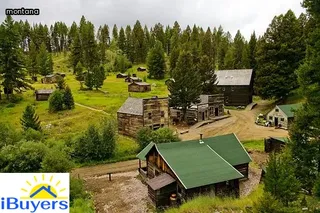Exploring the abandoned places of Montana is a unique experience. With so many ghost towns and abandoned houses, there's a lot to explore and discover.
From the remnants of an old logging town to an old homestead, these forgotten places have tales to tell about the past. While exploring these places can be exciting, caution should be taken as many are unsafe and could potentially contain hazardous materials.
Additionally, it's important to understand tenant abandonment laws in Montana as well as the process for disposing of personal property left behind in abandoned homes. With knowledge of the laws and safety precautions in place, exploring these historic locations can be a rewarding experience filled with stories from days gone by.

Montana has a long history of abandoned houses, stretching back to early settlers who found the state's remote and rugged terrain challenging. From the 1800s to the mid-1900s, many homesteaders left their homes due to changing economic conditions, health issues, or simply because they could no longer keep up with the demands of maintaining their property.
As a result, numerous abandoned homes have been scattered throughout Montana over the years. Today, these abandoned properties are often owned by private individuals or organizations who seek to preserve them as part of Montana's local history.
Many of these properties are subject to tenant abandonment laws, which can be confusing for those unfamiliar with the process. This guide aims to explain what tenant abandonment is and how it affects personal property in Montana.
It will also provide insight into how tenants can protect their rights when dealing with abandonment houses in Montana and what options are available for disposing of any remaining personal property after a tenant abandons a house.
Exploring the mysteries of abandoned houses in Montana is a fascinating journey. From the vast open plains to the towering Rocky Mountains, this incredible state has a rich history that can be found in its old buildings.
From ghost towns to dilapidated homesteads, many of these forgotten places are now home to long-forgotten secrets and tales. Taking a closer look at tenant abandonment and disposition of personal property in Montana can provide an interesting insight into this unique part of American history.
While some abandoned buildings have been repurposed as tourist attractions or homes for new families, others still remain untouched by time. Understanding why people left their homes, what became of their belongings, and how laws have changed over time can give us a better understanding of our past and help us protect these important pieces of history going forward.

Exploring abandoned houses in Montana offers a unique opportunity to discover the architectural beauty of these often forgotten gems. From mid-century modern dwellings to rustic farmhouses, there is something for everyone to appreciate in the state's abandoned homes.
Not only do these dwellings offer a glimpse into the past, but they also provide insight into tenant abandonment and how personal property is disposed of after a tenant has left. Whether it be by eviction or voluntary surrender, tenants must take certain steps to ensure that their belongings are properly taken care of after leaving an abode.
An exploration of Montana's abandoned houses can provide a fascinating look into this process as well as an appreciation for the state's unique architecture.
Exploring Montana's abandoned houses can be a treasure trove of forgotten items. While tenant abandonment and the subsequent disposition of personal property can be daunting tasks, they can also yield unexpected and exciting rewards.
By taking the time to research state laws and rules regarding tenant rights, any adventure into an abandoned house in Montana could result in a wealth of forgotten items. From antiques to jewelry, an abandoned house could hold all sorts of hidden treasures that have been left behind by previous tenants.
With a little bit of patience and knowledge about the laws surrounding tenant abandonment and disposition of personal property, you may be able to find some interesting items that have been long-forgotten.

Exploring the beauty of abandonment houses in Montana is an incredible experience. Once bustling with life, these abandoned structures are now left to the mercy of nature as trees and shrubs reclaim their territory.
With a visual appreciation for the state’s history, a person can find beauty in the delicate layers of paint that have been peeled away due to weathering, or marvel at how wildflowers and vines make their way through cracks to bring life back into these old homes. Each house tells its own unique story, from early settlers that called it home to the tenants who moved out and left it behind.
While exploring these abandoned dwellings, it's important to be aware of tenant abandonment laws and what rights a landlord has when disposing of personal property left behind in these empty houses. Taking time to explore Montana's abandoned houses is an opportunity for anyone interested in learning more about the area's history and visualizing its beauty before time takes them away forever.
Exploring Montana's abandoned houses is a great way to reconnect with nature and observe the beauty of the area. Visiting an abandoned house can provide a unique opportunity to see how nature has reclaimed a building, as well as learn more about tenant abandonment and disposition of personal property.
The process of tenant abandonment occurs when renters fail to pay rent or otherwise violate the terms of their lease agreement, resulting in eviction. Disposition of personal property left behind after tenant abandonment includes storing items in a warehouse, selling them at auction, or donating them to charity.
It is important to understand these concepts when visiting an abandoned house in Montana since many times there are still belongings left behind that need to be disposed of properly by the landlord or property manager. Exploring these properties can also provide insight into Montana's history and culture — giving visitors a glimpse into what life was like for previous generations who occupied the space long ago.

Exploring Montana's abandoned houses is an intriguing way to delve into the past and uncover the legacies of these eerie structures. From tenant abandonment to the disposition of personal property, there is much to learn about these lost homes.
Uncovering their stories can provide a greater understanding of why they were left behind in the first place. Documenting these tales can help preserve their memory and ensure that future generations can appreciate their history.
It also provides insight into how legal proceedings are handled when tenants leave without notice or paying rent. By exploring Montana's abandoned houses, we can gain a better understanding of our state's past and document the legacy of these ghostly structures for many years to come.
In Montana, tenant abandonment of property is considered to be a serious issue. Under state law, the landlord must wait a certain amount of time before they can consider the property abandoned and dispose of any personal property left behind by the tenant.
The length of this waiting period varies depending on the type of tenancy agreement that was in place when the tenant vacated the premises. A secure month-to-month tenancy requires a 30-day waiting period before the landlord can declare a tenant abandonment and dispose of any remaining personal belongings.
On the other hand, if a fixed-term lease was in effect when the tenant left, then Montana law states that landlords must wait until after the lease term has expired – usually six months – before declaring an abandonment. In either case, landlords must provide notice to tenants explaining their rights and obligations regarding any personal property left behind after abandoning their rental unit.
By understanding these legal requirements, landlords can ensure that they are complying with all relevant laws governing tenant abandonment and disposing of personal property in Montana.

In Montana, abandonment is defined as a tenant's vacating their rental property without proper notification to the landlord and without intent to return or reclaim their personal property. Tenants who abandon their residence are in breach of the lease agreement and may face legal action.
If the tenant fails to respond to the landlord's attempts to contact them for more than 30 days, then that constitutes abandonment in Montana. Abandonment can also be established if rent payments have not been made for more than 60 days, if utilities have been disconnected, or if all of the tenant's belongings have been removed from the rental unit.
In these cases, landlords may dispose of any remaining personal property according to Montana law.
Abandonment of a house is defined as when the tenant has vacated the premises without providing notice to the landlord or paying any rent due. The tenant may have left their personal possessions behind in the abandoned property, leaving the landlord with the responsibility of disposing of them.
This process is known as abandonment and disposition of personal property. In Montana, there are certain steps landlords must take before they can legally dispose of a tenant's belongings.
First, they must provide notice to the tenant that they intend to dispose of their belongings, and give them an opportunity to collect them from the property. If no response is received within 10 days, landlords can then proceed with disposing of any remaining items in accordance with state law.
It is important for landlords to understand their legal rights and obligations regarding tenant abandonment and disposition of personal property in order to avoid potential liability or dispute with tenants.
Montana Code 70-24-426 provides guidance on the tenant abandonment and disposition of personal property in abandoned rental units. This code covers situations where a tenant has left personal property behind after vacating the premises, and outlines the rights and duties of both the landlord and tenant when this situation arises.
Under Montana law, a landlord must give written notice to the tenant before taking possession of any abandoned personal property. The notice must include an itemized list of all items that have been left behind and must specify a time frame for removal.
If the tenant does not remove his/her belongings within this time period, then the landlord may keep or dispose of them in any manner he/she chooses. When disposing of these items, landlords are expected to make reasonable efforts to locate and contact the tenant before doing so, including searching public records or contacting relatives or friends.
It is important for tenants to be aware that they may be responsible for any costs associated with disposal if they fail to reclaim their belongings within the specified time frame.